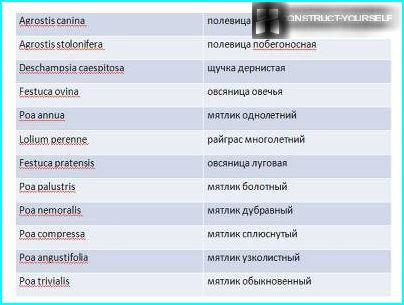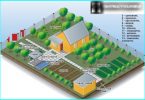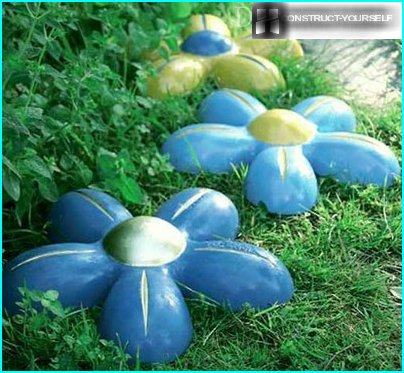
It happens that with proper care the lawn is still not pleased with their density, sometimes freezes during the winter and require frequent podstawow. All this – the consequences of incorrectly chosen herbal blend. When buying, we usually pay attention only to information for which type of lawn is suitable a mixture of (sports, ground, etc.). The herbs included in the composition, we are interested less, especially because their names usually say little. But this information is more important than the others, because in our country many mixtures imported from Europe. There the climate is milder, and criteria for the selection of turf grasses are not as rigid. But in our harsh climate the European the lawn frequently freezes because it includes not frost-resistant grass. To avoid such problems, the grass for the lawn should be selected according to the degree of adaptability to the climate and soils of your area. Let us examine this in more detail.
The contents
What requirements must meet quality grass?
Any ornamental grass for the lawn should be perennial, because the lawn creates more than one year, and each spring to seed the area in new ways does not make sense. Of all the types of plants most suited to the conditions of the lawn grass. But not all, but only those that meet the following requirements:
- Resistant to freezing.
- Decorative externally (juicy green colors, with a uniform germination of shoots, with the same density of cover, etc.).
- Develops a solid root system, which is not destroyed by the movement, capable of growing on compacted soils, etc..
- After cutting it is rapidly increasing the cover and respond well to fertilizers.
- The ability to reproduce vegetatively, because with the help of seeds on the lawn not to reproduce.
Most adapted for the Russian climate grass
If we analyze all the proposed mixtures of plants for the five listed criteria, then the diversity will be only three titles of grass for the lawn, ideally suited to the conditions of the Russian weather. It bent grass fine, red fescue and Kentucky bluegrass. They all belong to the group of short-rhizomatous grasses and have similar properties.
These plants are not afraid of contrasts of temperatures, especially frosts in the early spring or late fall. Their root system can withstand extreme cold and forms a dense turf so that through him to break through the weeds just unreal. 1 sq. m. is developing about 30 thousand shoots. Grass withstands frequent harvests, have a high rate of vegetative reproduction, so with proper care, the lawn will serve without podsunuv decades.
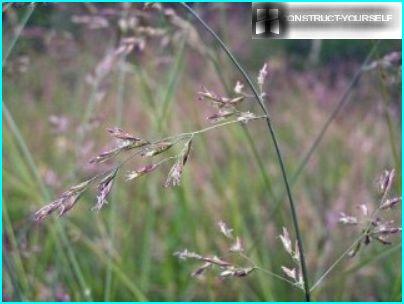
Red fescue grows relatively slowly, so for the first year of planting, the lawn will look poorly, but the next season, the plant creates a thick smooth cover
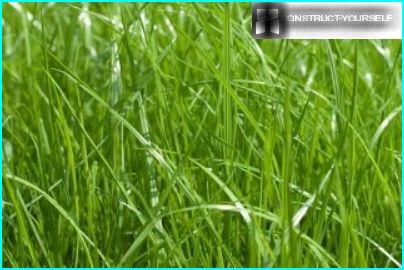
Kentucky bluegrass is not worth buying in its pure form, because it slowly builds up the root system. It is better to take a mix where it is the main component
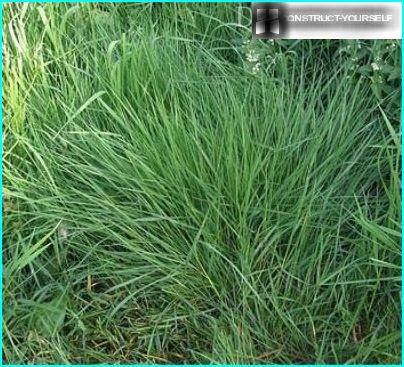
Thin bentgrass is famous not only for its hardiness and ruggedness, but also rich dark-green color, which gives the lawn a rich look
In the study of the composition of the mixes in the stores, choose for yourself those which the highest percentage of these grains. Sometimes the ingredients written on the packaging in Latin. Remember the sound of these three herbs in Latin:
- Thin bentgrass is referred to as Agrostis tenuis;
- Kentucky bluegrass is Poa pratensis;
- Red fescue is translated as Festuca rubra.
Additional components in the mixtures
In addition to three grains, in mixtures can meet and other plants suitable for the climate of our latitudes. All of them will be a good frost resistance and easy care. But there are some cons that do not allow to consider the best grass for the lawn. And if you find their names in the mixture, remember that they should not be the main component, but can be used as a Supplement.
List the types of herbs often used in mixtures for lawn:
- Bentgrass pobedonosnaya. Best quality – very rapid growth. Negative – gives horizontal shoots that stand out a light color against the dark green lawn. From this, the lawn becomes non-uniform color. This quality of place in the parterre lawns, although the recreation area is not so important.
- Other types of bluegrass. But the meadow which we have described previously, the compounds are narrow-leaved, common and oblate types of bluegrass. They have low durability, i.e. 5-7 years require replanting, and decorative properties below (grass blade too hard and with a bluish tinge).
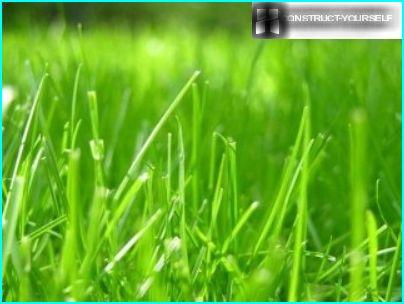
The light green color of horizontal shoots bent grass pobedonosnaya contrasts with the main color of lawn grass, so the grass is not suitable for parterre lawn
Herbs with specific properties
There are certain types of low-growing grasses for turf that are adapted to specific growing conditions. They cannot be called universal, but particular places on the site it is recommended to plant them.
So, bluegrass Asherah high ability to grow in partial shade. I.e., under the garden trees and in areas near buildings where the light rarely falls, this plant will save the lawn from bare spots and pale cover. However, you should note that bluegrass Asherah can’t form dense root system, so can not stand the traffic and frequent mowing.
Marsh bluegrass save the situation on the lawns with high humidity, where there was no drainage. It forms a beautiful green cover and develops strong roots, but short-lived and requires frequent podsekanie. It can be combined with the white bent grass, which also grows well on moist soil. But its decorative properties is lower than that of bluegrass, and it lasts about 8 years.
For parterre lawn on which walking is not planned at all, you can use the bent grass dog. This is one of the most elegant in appearance of herbs, because it has an emerald green color and soft, fine grass. Such a pitch is also called «velvet», because from a distance it looks like expensive fabric. But with all the external advantages, the plant is very capricious. It lives for about 5 years, and has weak roots, grows slowly and is completely resistant to trampling.
If you need to lawn to look aesthetically pleasing in a month or two, then pick up the mixture, which is fescue. It is the fastest growing grass, which will close its stems within 2 months. It can be used in pure form for a temporary lawn that is destined to grow in one place for 4 years, because the longer grass does not live. In addition, meadow fescue roots are weak, fearful of trampling. But a mixture of this grass can be very useful as a Supplement to the main grass. For example, Kentucky bluegrass grows slowly, and while he comes in at full strength, the empty space will cover the stems of meadow fescue.
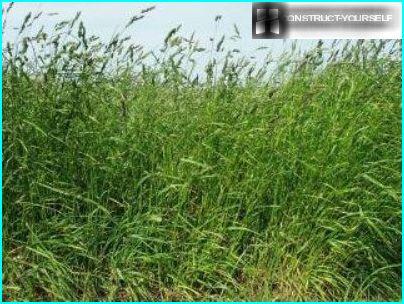
Fescue will save the owners when it is urgent to make a lawn ornamental, because after 2 months of grass form a continuous thick carpet
Your lawn will be thick in the summer, however, little bitty. In tall fescue meadow wide stalks and bright color, against the background of narrow dark green blades of grass bluegrass contrast will look. The following year, when the grass will go into a rapid growth, she’ll just squeeze this cereal and will take his place.
Grass, unsuitable to the Russian climate
In European mix there are herbs that should be avoided when planting on lawns because they are designed for a mild climate. For example, perennial ryegrass has excellent growth, decorative and thick cover, but after the first winter your lawn significantly «go bald», although in Europe, these green lawn successfully for about 8 years.
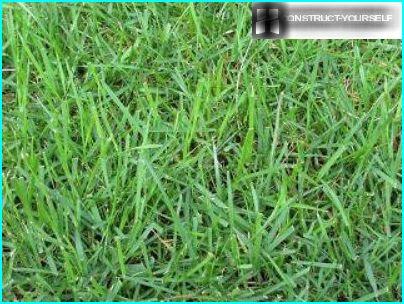
Perennial ryegrass (pasture) can satisfy only on the first year after planting. Harsh winter for him
Often found as an additional component of the mixture, annual bluegrass. Its peculiarity is the simplicity of maintenance and rapid growth. But this grass reproduces by seeds, so that when the permanent cuts next year he will not be able to produce offspring and release the ground for the germination of weeds.
More «two girlfriends» — turfy hair grass and sheep’s fescue — all good properties except that they eventually form the bumps, and gradually, your lawn will turn into a field of green hills.
Clues in Latin
To make it easier for you to navigate, by reading compounds of lawn mixes, and a better understanding of what grass lawn offers the manufacturer, we collected the names of the described herbs in Latin. Remember them and look for on the packaging:
